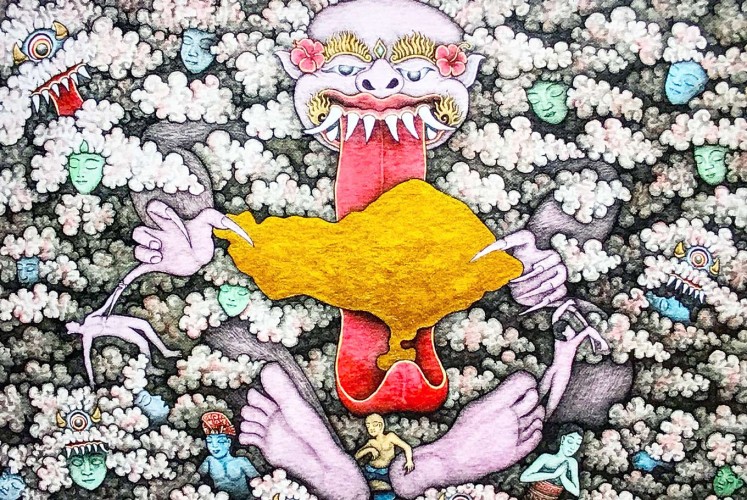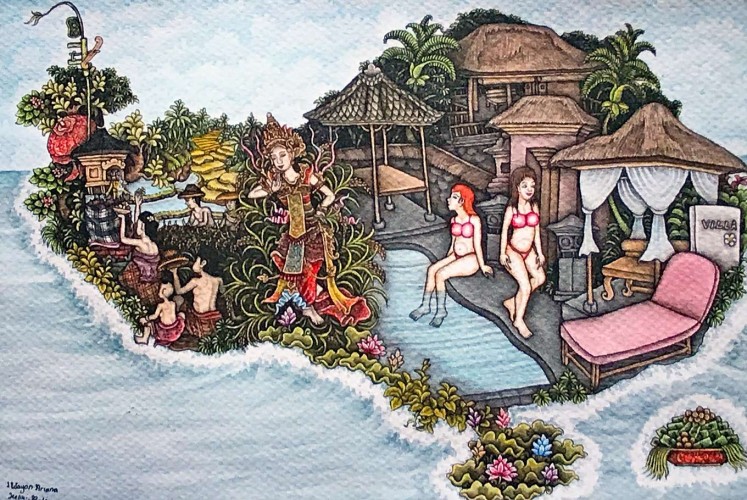Popular Reads
Top Results
Can't find what you're looking for?
View all search resultsPopular Reads
Top Results
Can't find what you're looking for?
View all search resultsThe charms of Keliki painting
A young painter uses a traditional style to tackle contemporary issues.
Change text size
Gift Premium Articles
to Anyone
I
t was midday and the temperature in Keliki, a hilly village north of Ubud, was already low by this tropical island’s standard when a light rain started pouring down on a spacious Balinese-style family compound.
Not even a cup of hot coffee that I Wayan Ariana (Instagram handle: @nanoeari_art) had just served could fight the sudden chill brought about by the rain.
“I am sorry, it is very cold here,” he said apologetically.
The talented young painter had just returned from the Kulidan Art Space (@kulidan.kitchen) in Sukawati where he fetched his artworks that had been displayed there for a brief exhibition in mid-July.
Ariana then shifted his gaze toward a group of eight local children, who huddled up at the compound’s west pavilion, who were learning to paint in the Keliki style, famous for its small-size and elaborately-detailed depiction of traditional Balinese daily life.
The chilling temperature apparently did not affect those kids. Four of them were busy completing their paintings, one was strutting around while singing the tune of a popular Balinese pop song, and the other three were enjoying ice cream.
“Kids, we have to let them learn at their own pace,” Ariana, who also teaches Hinduism at a local elementary school, said with a timid smile on his face before giving encouragement to his protégés.
I Wayan Ariana (JP/I Wayan Juniarta)The family compound is owned by Ariana’s older cousin I Wayan Gama, who opened the free-of-charge painting school in 2005 in an effort to preserve the then-declining Keliki painting style.
Read also: Miniature art takes stage at Keliki Kawan Exhibition 2017
“Prior to the 2002 Bali Bombings, nearly 60 percent of the adults here were painting in the Keliki style and they sold their works to visiting tourists,” he recalled.
The terrorist attack decimated the island’s tourism and, eventually, forced those Keliki painters to abandon painting and become construction workers or laborers to make ends meet.
“We provide the materials and mentorship for the children as well as help them sell their works to tourists,” he said, adding that the work of the children commanded prices ranging from Rp 200,000 (US$15) to Rp 500,000.
Devoured: A painting with a very somber theme: the island being devoured by an ogre symbolizing greedy investors. (JP/I Wayan Juniarta)The compound is also the place where 14 years ago Ariana picked up the pencil and brushes and learned the Keliki style for the first time.
Conceived by a farmer, I Ketut Sana in the 1970s, the Keliki style was, to a large extent, the local response to a growing tourist industry. The locals wanted to create a beautiful memento that the visitors could easily take back to their home countries. Hence, the miniature size of Keliki style paintings.
Keliki style paintings are mostly done on paper with Chinese ink and generally depict a romantic interpretation of daily life in the island’s rural villages, the beauty of the island’s flora and fauna, as well as Hindu myths and local folklore.
The style is famous for its rich gradations and extreme detail, both of which demand hours of prolonged concentration from the painter.
Popular opposition: A work by I Wayan Ariana shows his disapproval of the planned reclamation of Benoa Bay. (JP/I Wayan Juniarta)Unlike his seniors, Ariana took a bold step in a recent series of his works.
In this series, he utilized the Keliki style to address contemporary problems that haunt his home island.
Using the shape of Bali island as a visual landmark that appears throughout the series, he “speaks” about environmental degradation, uncontrolled tourism, corrupt officials and greedy investors, as well as his interpretation of the island’s spirituality.
Read also: Bali tourism development getting out of control: Communities
“The style was born in the 1970s and we need to make it relevant with recent developments in Bali,” he said.
In one work, he paints fishermen roaming the waters around the island while inside the island, three bright-colored excavators wreak havoc amid what appears to be a pristine jungle and people engaged in a temple ritual. The work is clearly a homage to the island’s popular grass-roots movement against the planned reclamation of Benoa Bay. The image of a damaged excavator in the movement’s signature poster has become one of the most iconic images of 21st century Bali.
“Yes, I oppose the planned reclamation. It will negatively impact our environment and the livelihood of our fishermen. I believe we need to reevaluate the way we develop our tourist industry here,” Ariana said.
Critical eye: Ariana uses a traditional style of painting to address contemporary issues. (JP/I Wayan Juniarta)
The paintings have been published in a book entitled Bali, Preserving the Paradise, which was launched last June in Keliki. The deluxe, limited edition copy features 24 works from the series.
It is available from Littletalks (@littletalksubud), a charming library café overlooking Campuhan gorge in Ubud, where Ariana will hold his next solo exhibition in November.
With Ariana, the Keliki style has come full circle. The style, whose birth was spurred by tourism, has now started to look at that lucrative industry with a critical eye.















